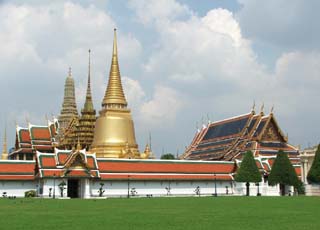
Wat Phra Kaew Bangkok Thailand, A lot of first time visitors aren't quite sure what to expect when first arriving in the capital of exotic
Thailand, and some may be disappointed by their first impressions on the way into town - endless high rise buildings, busy expressway flyovers and billboards of western companies advertising in English. Yet while Bangkok has undoubtedly embraced westernization and modernization, you only need to look a little under the surface to see that it remains undeniably a Thai place at heart. In between the skyscrapers and sophisticated shopping centers there's still the remarkable
Wat Phra Kaew and the Grand Palace , the Temple of the Dawn and many more. Traditions live on too: don't be surprised, for example, to find a large dedicated spirit house built for good luck alongside almost every major building, or to see files of Buddhist monks making their early morning alms round - and it's surely one of the only major cities in the world where seeing an elephant paraded round the streets hardly even ranks as being unusual.
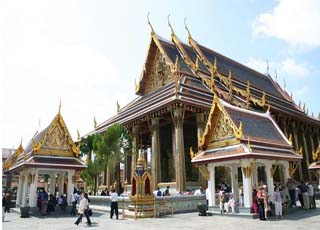
Wat Phra Kaew Bangkok Thailand, Amidst all of this is what many find one of Asia's most interesting and exciting cities, but it does have it's fair share of problems also - not least of which is the heat. Due to it's location in the tropics, Bangkok's average day time temperature is rarely much below 30 degrees centigrade at any time of year and the night time temperature is not much cooler. The maximum temperature can occasionally top 40 degrees during the hot season in April / May, when it is, not surprisingly, the low season for tourism. Despite the temperature, it is not all that sunny in Bangkok and most days are grey and overcast - meaning many visitors are surprised when they first walk outside Bangkok airport and discover that what appeared to be a cold, cloudy day is actually uncomfortably hot.
The heat, combined with the humidity and pollution, makes walking a sizable distance in
Bangkok almost impossible, and breaking into a sweat after only a couple of hundred meters almost inevitable. The Thai people themselves will rarely walk any significant distance and there's a very large number of cars, buses, taxis and tuk-tuks to help them get about.
Source : into-asia.com
 Wat Saket is one of the oldest temples in Bangkok, was built by King Rama I in the late 18th century. The first Golden Mount was built by King Rama III but the soft soil led to its collapse. The Golden Mount which is seen today, created by King Chulalongkorn (Rama V).
Wat Saket is one of the oldest temples in Bangkok, was built by King Rama I in the late 18th century. The first Golden Mount was built by King Rama III but the soft soil led to its collapse. The Golden Mount which is seen today, created by King Chulalongkorn (Rama V).
















 The tiger are taken out from cage during 1530hrs. - 1700hrs. that you can see them closely and able to touch the tigers!! Wat Pa Luangta Bua Yannasampanno Forest Monastery was established by the Abbot-Phra Acharn Phusit (Chan) Kanthitharo in 1994.
The tiger are taken out from cage during 1530hrs. - 1700hrs. that you can see them closely and able to touch the tigers!! Wat Pa Luangta Bua Yannasampanno Forest Monastery was established by the Abbot-Phra Acharn Phusit (Chan) Kanthitharo in 1994. Wat Rajabopit Sathitmaha Simaram Rajaworavihara (Wat Rajabopit) is situated between Fuang Nakhon Road and Usadang Road ( Khlong Ku Muang Derm Road ) near the Ministry of Interior in
Wat Rajabopit Sathitmaha Simaram Rajaworavihara (Wat Rajabopit) is situated between Fuang Nakhon Road and Usadang Road ( Khlong Ku Muang Derm Road ) near the Ministry of Interior in  Wat Sothon Wararam Worawihan is located on the west bank of the Bang Pakong River in Amphoe Muang approximately two kilometers south of Sala Mang (the City Hall). This monastery houses Phra Phutthasothon or as commonly called by the local folk "Luang Pho Sothon".
Wat Sothon Wararam Worawihan is located on the west bank of the Bang Pakong River in Amphoe Muang approximately two kilometers south of Sala Mang (the City Hall). This monastery houses Phra Phutthasothon or as commonly called by the local folk "Luang Pho Sothon". Khao (Mountain) Phra Bat is the hill to the south of Pattaya, the famous
Khao (Mountain) Phra Bat is the hill to the south of Pattaya, the famous  This Buddhist temple located on the southern outskirts of
This Buddhist temple located on the southern outskirts of  Wat Jedee Luang on Prapokklao Road is the side of a formerly massive pagoda that was unfortunately destroyed in the great earthquake of 1545. The Jedee Luang temple was originally constructed in 1401 by the orders of King Saeng Muang Ma (
Wat Jedee Luang on Prapokklao Road is the side of a formerly massive pagoda that was unfortunately destroyed in the great earthquake of 1545. The Jedee Luang temple was originally constructed in 1401 by the orders of King Saeng Muang Ma (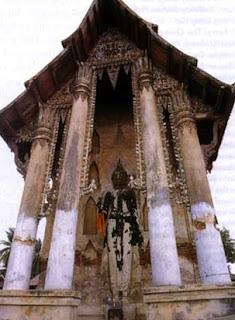 Wat Dusidaram Woravihara ( Wat Dusid ) was founded in the
Wat Dusidaram Woravihara ( Wat Dusid ) was founded in the 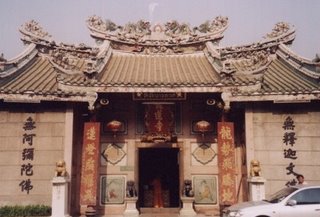 At the heart of Bangkok's Chinatown is the Chinese-Buddhist temple of Wat Mangkon Kamalawat, known in Chinese as Wat Leng Nui Yee. The temple is the center of festivities during important festivals such as
At the heart of Bangkok's Chinatown is the Chinese-Buddhist temple of Wat Mangkon Kamalawat, known in Chinese as Wat Leng Nui Yee. The temple is the center of festivities during important festivals such as 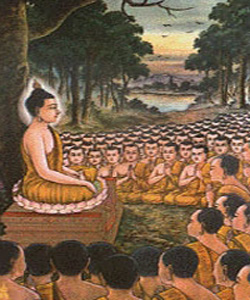 1. There were 1,250 Sangha followers, that came to see the Buddha that evening without any schedule.
1. There were 1,250 Sangha followers, that came to see the Buddha that evening without any schedule.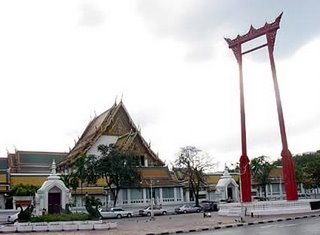 Its a bit off the tourist trail these days, but Wat Suthat is still a very important temple to the Thais. This is the home of the Brahmin priest who oversee royal rituals such as the ploughing ceremony held at the traditional beginning of the growing season.
Its a bit off the tourist trail these days, but Wat Suthat is still a very important temple to the Thais. This is the home of the Brahmin priest who oversee royal rituals such as the ploughing ceremony held at the traditional beginning of the growing season.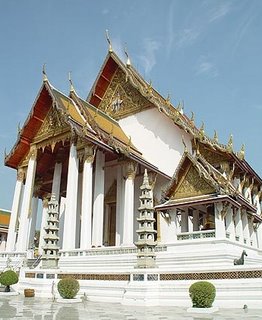 The courtyard between the Buddha gallery and the wiharn is full of chinese statues reported to have been shipped from China as ballast in rice boats during the reign of Bangkok's first king.
The courtyard between the Buddha gallery and the wiharn is full of chinese statues reported to have been shipped from China as ballast in rice boats during the reign of Bangkok's first king.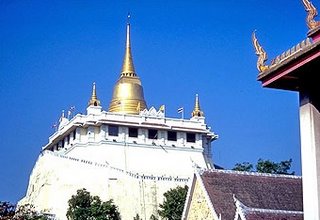 The grubby yellow hill crowned with a gleaming gold chedi is also known as the Golden Mount, or 'Phu Khao Thong'. It rises within the compound of Wat Saket, an unusual temple that houses Buddha relics within its 58-metre-high chedi surmounted by a golden cupola. Built by King Rama I just outside the new city walls, the late-18th century temple served as the capital's crematorium. During the following 100 years, the temple became the dumping ground for some 60,000 plague victims.
The grubby yellow hill crowned with a gleaming gold chedi is also known as the Golden Mount, or 'Phu Khao Thong'. It rises within the compound of Wat Saket, an unusual temple that houses Buddha relics within its 58-metre-high chedi surmounted by a golden cupola. Built by King Rama I just outside the new city walls, the late-18th century temple served as the capital's crematorium. During the following 100 years, the temple became the dumping ground for some 60,000 plague victims.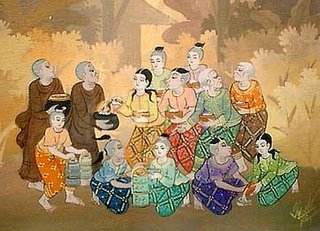 Thai. To perform a good deed or to make merit (tamboon) by giving an offering into (sai) the alms bowl (baat) of a Buddhist monk. Sometimes in
Thai. To perform a good deed or to make merit (tamboon) by giving an offering into (sai) the alms bowl (baat) of a Buddhist monk. Sometimes in 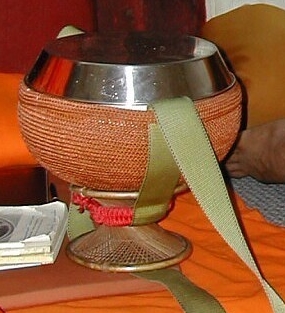 Thais. De bedelkom van een monnik. Bedelkommmen worden reeds gedurende meer dan 2.500 jaar gebruikt voor de bintabaat of bedelronde van monniken in de vroege ochtend, een traditie die tot op heden voortduurt. Het produktieproces van een bedelkom is erg tijdsrovend waardoor er slechts enkelen per dag kunnen worden vervaardigd. Ze worden samengesteld uit acht stukken metaal, die de acht spaken van de dhammachakka, het boeddhistische Wiel der Wet, en het Achtvoudige Pad vertegenwoordigen. Een eerste metalen strip wordt in een ronde vorm geslaan om de rand van de kom te maken. Vervolgens worden drie stukken in een bolle kruisvorm geslaan om het skelet te vormen, waarna vier driehoekige stukjes de zijkanten vervolledigen. De bedelkom wordt vervolgens in een oven aaneengesmeden en gevormd. Nadien wordt ze herhaaldelijk glad gewreven en verwarmd om het oppervlak glanzend te maken. Bedelkommen worden tegenwoordig nog steeds vervaardigd in Bangkok's Ban Baat of 'Bedelkom Dorp', in de achterstraatjes van Bamrung Meuang Road in het district Pomprap Sattruphai.
Thais. De bedelkom van een monnik. Bedelkommmen worden reeds gedurende meer dan 2.500 jaar gebruikt voor de bintabaat of bedelronde van monniken in de vroege ochtend, een traditie die tot op heden voortduurt. Het produktieproces van een bedelkom is erg tijdsrovend waardoor er slechts enkelen per dag kunnen worden vervaardigd. Ze worden samengesteld uit acht stukken metaal, die de acht spaken van de dhammachakka, het boeddhistische Wiel der Wet, en het Achtvoudige Pad vertegenwoordigen. Een eerste metalen strip wordt in een ronde vorm geslaan om de rand van de kom te maken. Vervolgens worden drie stukken in een bolle kruisvorm geslaan om het skelet te vormen, waarna vier driehoekige stukjes de zijkanten vervolledigen. De bedelkom wordt vervolgens in een oven aaneengesmeden en gevormd. Nadien wordt ze herhaaldelijk glad gewreven en verwarmd om het oppervlak glanzend te maken. Bedelkommen worden tegenwoordig nog steeds vervaardigd in Bangkok's Ban Baat of 'Bedelkom Dorp', in de achterstraatjes van Bamrung Meuang Road in het district Pomprap Sattruphai. Sometimes known as the Royal Park or Royal Field, Sanam Luang is right in the centre of the Rattanakosin (Old City) part of Bangkok. A large oval-shaped park, Sanam Luang has a number of royal connections and is where the King appears during his annual 5 December birthday celebrations. Royal cremations are also held here and it is also the venue for the annual Royal Ploughing Ceremony. From February to May you can see Kite Flying at the park. There are often competitions for the most ornate and most beautiful kites. It's very interesting to walk around Sanam Luang in the early evening you can see fortune tellers (Mor Doo), people selling a variety of wares, and even masseurs offering traditional massage in the open!
Sometimes known as the Royal Park or Royal Field, Sanam Luang is right in the centre of the Rattanakosin (Old City) part of Bangkok. A large oval-shaped park, Sanam Luang has a number of royal connections and is where the King appears during his annual 5 December birthday celebrations. Royal cremations are also held here and it is also the venue for the annual Royal Ploughing Ceremony. From February to May you can see Kite Flying at the park. There are often competitions for the most ornate and most beautiful kites. It's very interesting to walk around Sanam Luang in the early evening you can see fortune tellers (Mor Doo), people selling a variety of wares, and even masseurs offering traditional massage in the open!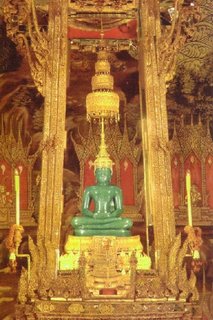 The Temple of the Emerald Buddha or Wat phra Rattanasatsadaram (
The Temple of the Emerald Buddha or Wat phra Rattanasatsadaram ( Wat Phra Kaew Bangkok Thailand, A lot of first time visitors aren't quite sure what to expect when first arriving in the capital of exotic
Wat Phra Kaew Bangkok Thailand, A lot of first time visitors aren't quite sure what to expect when first arriving in the capital of exotic  Wat Phra Kaew Bangkok Thailand, Amidst all of this is what many find one of Asia's most interesting and exciting cities, but it does have it's fair share of problems also - not least of which is the heat. Due to it's location in the tropics, Bangkok's average day time temperature is rarely much below 30 degrees centigrade at any time of year and the night time temperature is not much cooler. The maximum temperature can occasionally top 40 degrees during the hot season in April / May, when it is, not surprisingly, the low season for tourism. Despite the temperature, it is not all that sunny in Bangkok and most days are grey and overcast - meaning many visitors are surprised when they first walk outside Bangkok airport and discover that what appeared to be a cold, cloudy day is actually uncomfortably hot.
Wat Phra Kaew Bangkok Thailand, Amidst all of this is what many find one of Asia's most interesting and exciting cities, but it does have it's fair share of problems also - not least of which is the heat. Due to it's location in the tropics, Bangkok's average day time temperature is rarely much below 30 degrees centigrade at any time of year and the night time temperature is not much cooler. The maximum temperature can occasionally top 40 degrees during the hot season in April / May, when it is, not surprisingly, the low season for tourism. Despite the temperature, it is not all that sunny in Bangkok and most days are grey and overcast - meaning many visitors are surprised when they first walk outside Bangkok airport and discover that what appeared to be a cold, cloudy day is actually uncomfortably hot.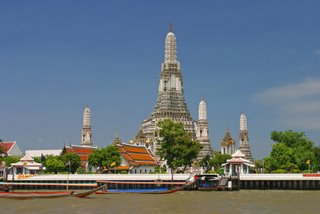 Wat Arun, the Temple of Dawn, is one of Bangkok's best know landmark. It stands on the west bank of the Chao Phraya River in Thon Buri. Wat Arun is best seen from the opposite bank of the river; it glistens in the sunlight during the day and stands dark and noble at dawn or dusk. A visit to the beautiful, peaceful monastery complex surrounding the familiar towers is very worth-while. These towers, the "Phra Prang," although best known, the only part of Wat Arun. It also contains narrow lanes; elegant, old white buildings; shrines, pools of turtles; and two fine giants, " Yuk Wat Jaeng," mortal enemies of the " Yuk Wat Po" across the river.
Wat Arun, the Temple of Dawn, is one of Bangkok's best know landmark. It stands on the west bank of the Chao Phraya River in Thon Buri. Wat Arun is best seen from the opposite bank of the river; it glistens in the sunlight during the day and stands dark and noble at dawn or dusk. A visit to the beautiful, peaceful monastery complex surrounding the familiar towers is very worth-while. These towers, the "Phra Prang," although best known, the only part of Wat Arun. It also contains narrow lanes; elegant, old white buildings; shrines, pools of turtles; and two fine giants, " Yuk Wat Jaeng," mortal enemies of the " Yuk Wat Po" across the river.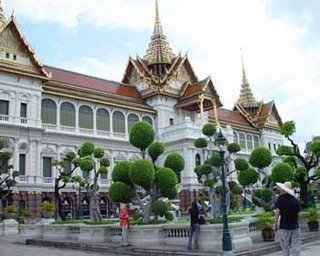 The Grand Palace and Wat Phra Kaew really are places you must visit while you are in Bangkok. Both have considerable historical significance and are extremely beautiful places to see.
The Grand Palace and Wat Phra Kaew really are places you must visit while you are in Bangkok. Both have considerable historical significance and are extremely beautiful places to see.
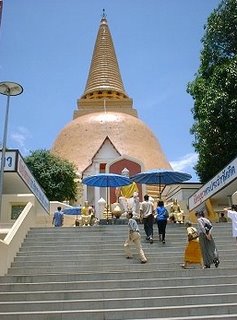 On coming toward the Nakhon Pathom city, the first glimpse of the towering Phra Pathom Chedi is overpowering. lt is one of the largest pagodas in the world and in
On coming toward the Nakhon Pathom city, the first glimpse of the towering Phra Pathom Chedi is overpowering. lt is one of the largest pagodas in the world and in